Page 445 of 618
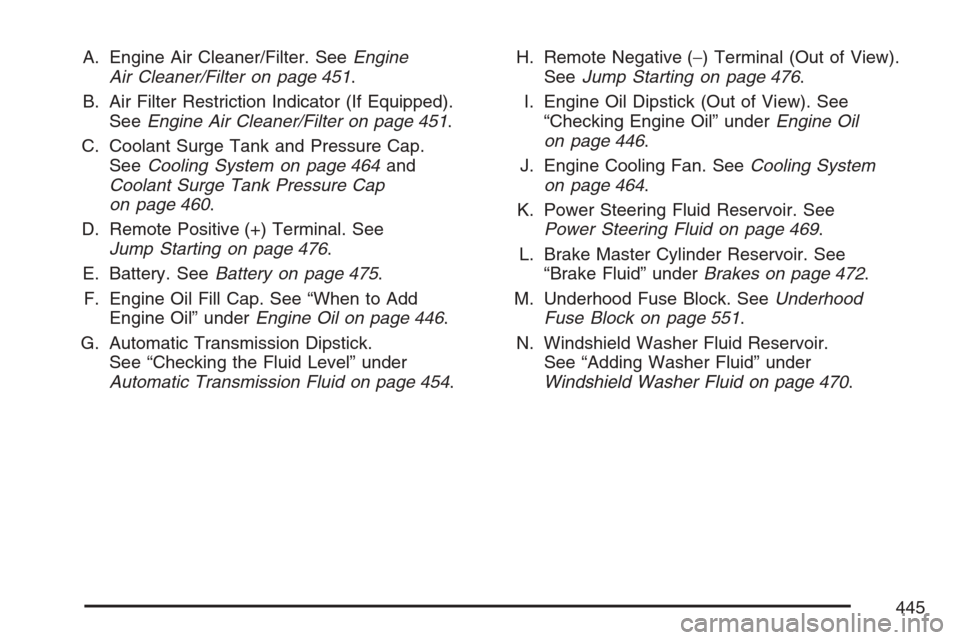
A. Engine Air Cleaner/Filter. SeeEngine
Air Cleaner/Filter on page 451.
B. Air Filter Restriction Indicator (If Equipped).
SeeEngine Air Cleaner/Filter on page 451.
C. Coolant Surge Tank and Pressure Cap.
SeeCooling System on page 464and
Coolant Surge Tank Pressure Cap
on page 460.
D. Remote Positive (+) Terminal. See
Jump Starting on page 476.
E. Battery. SeeBattery on page 475.
F. Engine Oil Fill Cap. See “When to Add
Engine Oil” underEngine Oil on page 446.
G. Automatic Transmission Dipstick.
See “Checking the Fluid Level” under
Automatic Transmission Fluid on page 454.H. Remote Negative (−) Terminal (Out of View).
SeeJump Starting on page 476.
I. Engine Oil Dipstick (Out of View). See
“Checking Engine Oil” underEngine Oil
on page 446.
J. Engine Cooling Fan. SeeCooling System
on page 464.
K. Power Steering Fluid Reservoir. See
Power Steering Fluid on page 469.
L. Brake Master Cylinder Reservoir. See
“Brake Fluid” underBrakes on page 472.
M. Underhood Fuse Block. SeeUnderhood
Fuse Block on page 551.
N. Windshield Washer Fluid Reservoir.
See “Adding Washer Fluid” under
Windshield Washer Fluid on page 470.
445
Page 446 of 618
Engine Oil
If the CHECK OIL LEVEL message in the Driver
Information Center (DIC) comes on, check the
engine oil level right away. For more information,
see CHECK OIL LEVEL underDIC Warnings and
Messages on page 267. You should check the
engine oil level regularly; this is an added reminder.
Checking Engine Oil
It is a good idea to check the engine oil every time
you get fuel. In order to get an accurate reading,
the oil must be warm and the vehicle must be
on level ground.The engine oil dipstick handle is a yellow loop.
SeeEngine Compartment Overview on page 444
for the location of the engine oil dipstick.
1. Turn off the engine and give the oil several
minutes to drain back into the oil pan. If you
do not do this, the oil dipstick might not
show the actual level.
2. Pull out the dipstick and clean it with a paper
towel or cloth, then push it back in all the
way. Remove it again, keeping the tip down,
and check the level.
446
Page 449 of 618
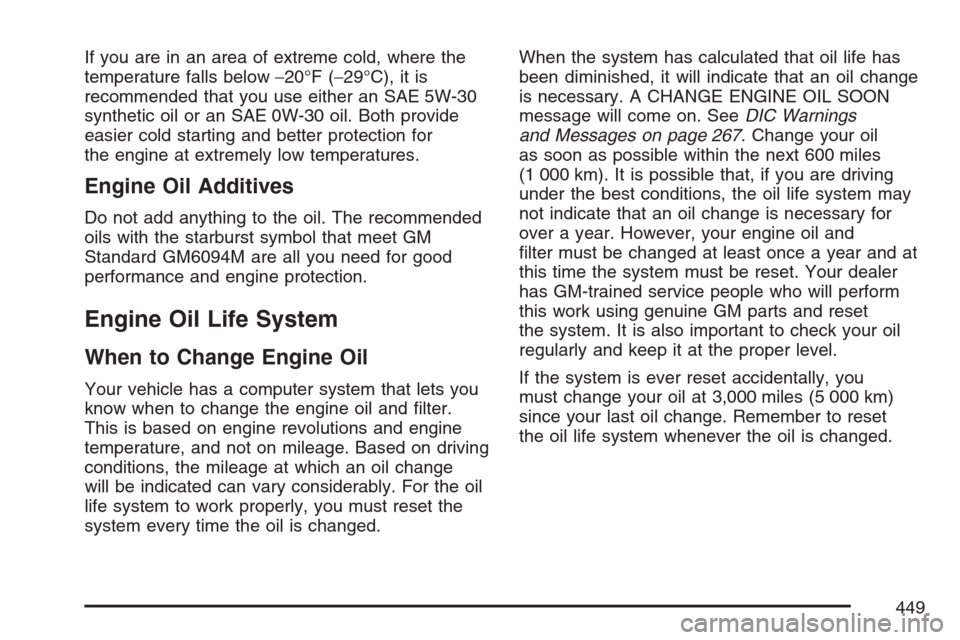
If you are in an area of extreme cold, where the
temperature falls below−20°F (−29°C), it is
recommended that you use either an SAE 5W-30
synthetic oil or an SAE 0W-30 oil. Both provide
easier cold starting and better protection for
the engine at extremely low temperatures.
Engine Oil Additives
Do not add anything to the oil. The recommended
oils with the starburst symbol that meet GM
Standard GM6094M are all you need for good
performance and engine protection.
Engine Oil Life System
When to Change Engine Oil
Your vehicle has a computer system that lets you
know when to change the engine oil and �lter.
This is based on engine revolutions and engine
temperature, and not on mileage. Based on driving
conditions, the mileage at which an oil change
will be indicated can vary considerably. For the oil
life system to work properly, you must reset the
system every time the oil is changed.When the system has calculated that oil life has
been diminished, it will indicate that an oil change
is necessary. A CHANGE ENGINE OIL SOON
message will come on. SeeDIC Warnings
and Messages on page 267. Change your oil
as soon as possible within the next 600 miles
(1 000 km). It is possible that, if you are driving
under the best conditions, the oil life system may
not indicate that an oil change is necessary for
over a year. However, your engine oil and
�lter must be changed at least once a year and at
this time the system must be reset. Your dealer
has GM-trained service people who will perform
this work using genuine GM parts and reset
the system. It is also important to check your oil
regularly and keep it at the proper level.
If the system is ever reset accidentally, you
must change your oil at 3,000 miles (5 000 km)
since your last oil change. Remember to reset
the oil life system whenever the oil is changed.
449
Page 454 of 618
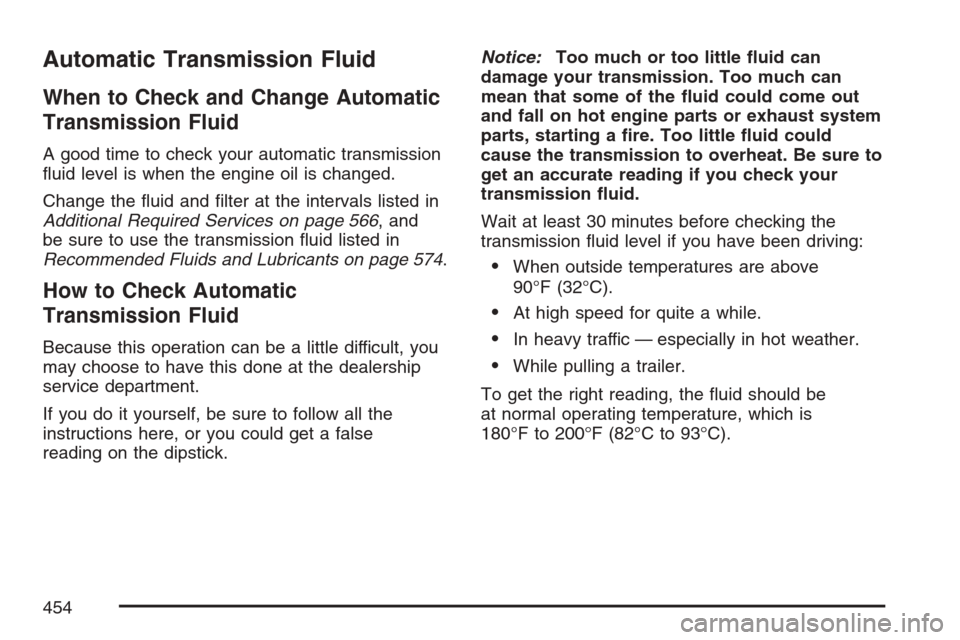
Automatic Transmission Fluid
When to Check and Change Automatic
Transmission Fluid
A good time to check your automatic transmission
�uid level is when the engine oil is changed.
Change the �uid and �lter at the intervals listed in
Additional Required Services on page 566, and
be sure to use the transmission �uid listed in
Recommended Fluids and Lubricants on page 574.
How to Check Automatic
Transmission Fluid
Because this operation can be a little difficult, you
may choose to have this done at the dealership
service department.
If you do it yourself, be sure to follow all the
instructions here, or you could get a false
reading on the dipstick.Notice:Too much or too little �uid can
damage your transmission. Too much can
mean that some of the �uid could come out
and fall on hot engine parts or exhaust system
parts, starting a �re. Too little �uid could
cause the transmission to overheat. Be sure to
get an accurate reading if you check your
transmission �uid.
Wait at least 30 minutes before checking the
transmission �uid level if you have been driving:
When outside temperatures are above
90°F (32°C).
At high speed for quite a while.
In heavy traffic — especially in hot weather.
While pulling a trailer.
To get the right reading, the �uid should be
at normal operating temperature, which is
180°F to 200°F (82°C to 93°C).
454
Page 464 of 618
Cooling System
When you decide it is safe to lift the hood,
here is what you will see:
A. Coolant Surge Tank
B. Coolant Surge Tank Pressure Cap
C. Engine Cooling Fan(s){CAUTION:
An electric fan under the hood can start up
and injure you even when the engine is not
running. Keep hands, clothing, and tools
away from any underhood electric fan.
If the coolant inside the coolant surge tank is
boiling, do not do anything else until it cools down.
If possible, the vehicle should be parked on a
level surface. Check the coolant level after
the system cools down. Some amount of coolant
may be lost due to overheating.
5.3L Engine (6.0L Similar)
464
Page 473 of 618
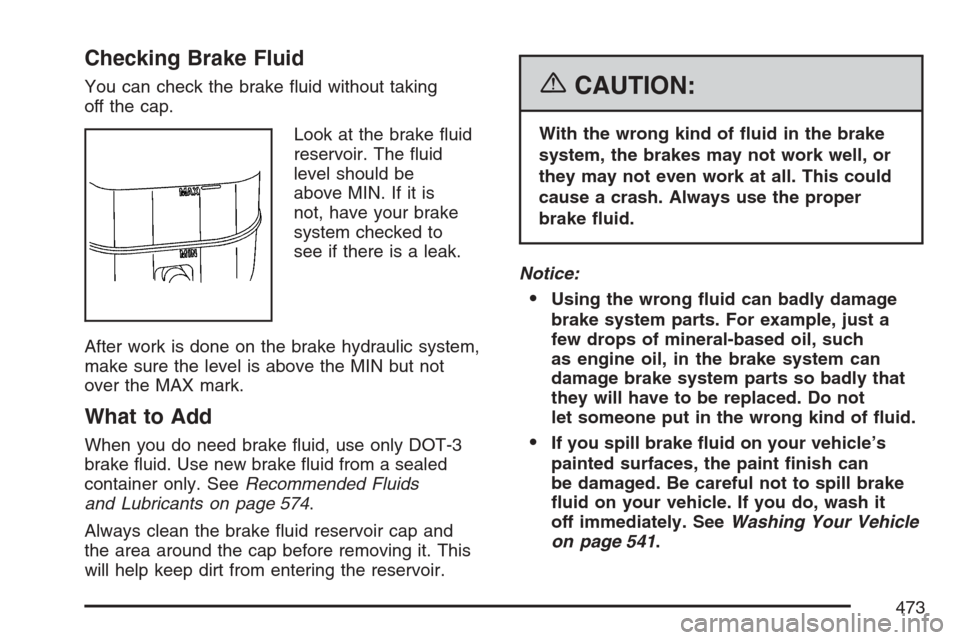
Checking Brake Fluid
You can check the brake �uid without taking
off the cap.
Look at the brake �uid
reservoir. The �uid
level should be
above MIN. If it is
not, have your brake
system checked to
see if there is a leak.
After work is done on the brake hydraulic system,
make sure the level is above the MIN but not
over the MAX mark.
What to Add
When you do need brake �uid, use only DOT-3
brake �uid. Use new brake �uid from a sealed
container only. SeeRecommended Fluids
and Lubricants on page 574.
Always clean the brake �uid reservoir cap and
the area around the cap before removing it. This
will help keep dirt from entering the reservoir.
{CAUTION:
With the wrong kind of �uid in the brake
system, the brakes may not work well, or
they may not even work at all. This could
cause a crash. Always use the proper
brake �uid.
Notice:
Using the wrong �uid can badly damage
brake system parts. For example, just a
few drops of mineral-based oil, such
as engine oil, in the brake system can
damage brake system parts so badly that
they will have to be replaced. Do not
let someone put in the wrong kind of �uid.
If you spill brake �uid on your vehicle’s
painted surfaces, the paint �nish can
be damaged. Be careful not to spill brake
�uid on your vehicle. If you do, wash it
off immediately. SeeWashing Your Vehicle
on page 541.
473
Page 542 of 618
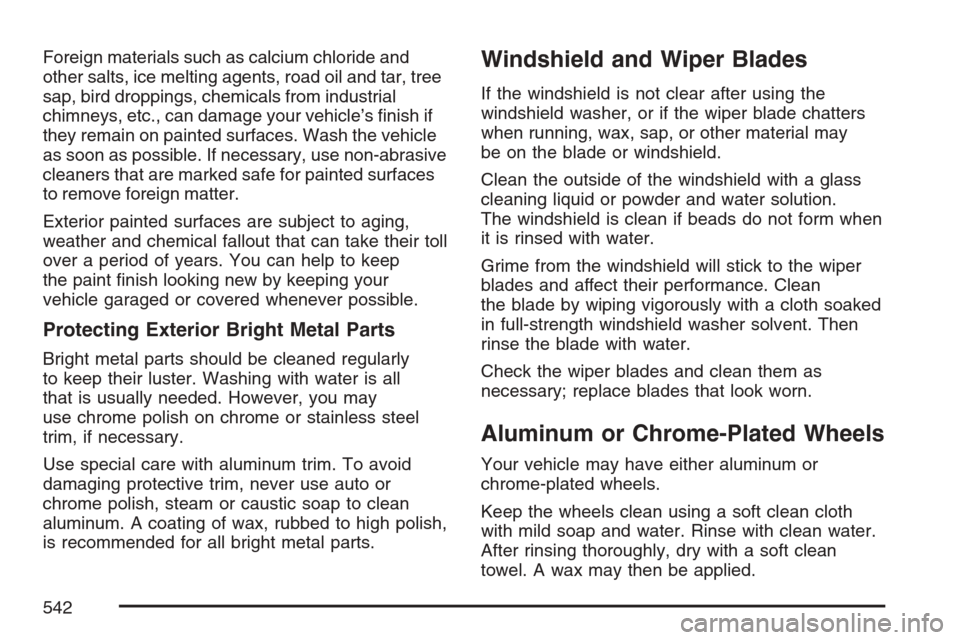
Foreign materials such as calcium chloride and
other salts, ice melting agents, road oil and tar, tree
sap, bird droppings, chemicals from industrial
chimneys, etc., can damage your vehicle’s �nish if
they remain on painted surfaces. Wash the vehicle
as soon as possible. If necessary, use non-abrasive
cleaners that are marked safe for painted surfaces
to remove foreign matter.
Exterior painted surfaces are subject to aging,
weather and chemical fallout that can take their toll
over a period of years. You can help to keep
the paint �nish looking new by keeping your
vehicle garaged or covered whenever possible.
Protecting Exterior Bright Metal Parts
Bright metal parts should be cleaned regularly
to keep their luster. Washing with water is all
that is usually needed. However, you may
use chrome polish on chrome or stainless steel
trim, if necessary.
Use special care with aluminum trim. To avoid
damaging protective trim, never use auto or
chrome polish, steam or caustic soap to clean
aluminum. A coating of wax, rubbed to high polish,
is recommended for all bright metal parts.
Windshield and Wiper Blades
If the windshield is not clear after using the
windshield washer, or if the wiper blade chatters
when running, wax, sap, or other material may
be on the blade or windshield.
Clean the outside of the windshield with a glass
cleaning liquid or powder and water solution.
The windshield is clean if beads do not form when
it is rinsed with water.
Grime from the windshield will stick to the wiper
blades and affect their performance. Clean
the blade by wiping vigorously with a cloth soaked
in full-strength windshield washer solvent. Then
rinse the blade with water.
Check the wiper blades and clean them as
necessary; replace blades that look worn.
Aluminum or Chrome-Plated Wheels
Your vehicle may have either aluminum or
chrome-plated wheels.
Keep the wheels clean using a soft clean cloth
with mild soap and water. Rinse with clean water.
After rinsing thoroughly, dry with a soft clean
towel. A wax may then be applied.
542
Page 556 of 618
Capacities and Speci�cations
The following approximate capacities are given in English and metric conversions. SeeRecommended
Fluids and Lubricants on page 574for more information.
ApplicationCapacities
English Metric
Air Conditioning Refrigerant R134aFor the air conditioning system refrigerant charge
amount, see the refrigerant caution label located
under the hood. See your dealer for more information.
Cooling System
5.3L V8, 5.3L V8 Flexible Fuel and 6.0L V8 16.8 qt 15.9 L
Engine Oil with Filter
5.3L V8, 5.3L V8 Flexible Fuel, 6.0L V8 6.0 qt† 5.7 L†
Fuel Tank 31.5 gal 119.2 L
Transmission Fluid 5.0 qt 4.7 L
Transfer Case Fluid 2.0 qt 1.9 L
Wheel Nut Torque 140 lb ft
190Y
†Oil �lter should be changed at every oil change.
After re�ll, the level must be rechecked. Add enough engine coolant so that the �uid is within the proper
operating range.
556